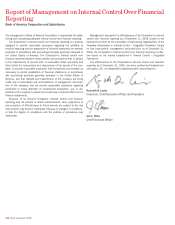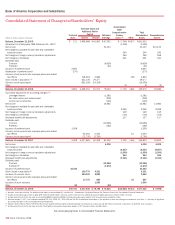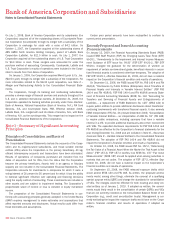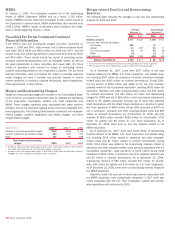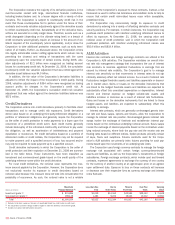Bank of America 2008 Annual Report Download - page 126
Download and view the complete annual report
Please find page 126 of the 2008 Bank of America annual report below. You can navigate through the pages in the report by either clicking on the pages listed below, or by using the keyword search tool below to find specific information within the annual report.Corporation will reclassify the associated net unrealized loss out of
accumulated OCI with a corresponding adjustment to equity investment
income. Dividend income on all AFS marketable equity securities is
included in equity investment income. Realized gains and losses on the
sale of all AFS marketable equity securities, which are recorded in equity
investment income, are determined using the specific identification
method.
Equity investments held by Principal Investing, a diversified equity
investor in companies at all stages of their life cycle from startup to
buyout, are reported at fair value pursuant to the American Institute of
Certified Public Accountants (AICPA) Investment Company Audit Guide and
recorded in other assets. These investments are made either directly in a
company or held through a fund. Equity investments for which there are
active market quotes are carried at estimated fair value based on market
prices. Nonpublic and other equity investments for which representative
market quotes are not readily available are initially valued at the trans-
action price. Subsequently, the Corporation adjusts valuations when evi-
dence is available to support such adjustments. Such evidence includes
changes in value as a result of initial public offerings (IPO), market com-
parables, market liquidity, the investees’ financial results, sales
restrictions, or other-than-temporary declines in value. The carrying value
of private equity investments reflects expected exit values based upon
market prices or other valuation methodologies including expected cash
flows and market comparables of similar companies. Additionally, certain
private equity investments that are not accounted for under the AICPA
Investment Company Audit Guide may be carried at fair value in accord-
ance with SFAS No. 159 “Fair Value Option for Financial Assets and
Liabilities” (SFAS 159). Gains and losses on these equity investments,
both unrealized and realized, are recorded in equity investment income.
Equity investments without readily determinable market values are
recorded in other assets, are accounted for using the cost method and
are subject to impairment testing if applicable.
Loans and Leases
Loans measured at historical cost are reported at their outstanding princi-
pal balances net of any unearned income, charge-offs, unamortized
deferred fees and costs on originated loans, and premiums or discounts
on purchased loans. Loan origination fees and certain direct origination
costs are deferred and recognized as adjustments to income over the
lives of the related loans. Unearned income, discounts and premiums are
amortized to interest income using methods that approximate the interest
method. Subsequent to the adoption of SFAS 159, on January 1, 2007
the Corporation elected the fair value option for certain loans. Fair values
for these loans are based on market prices, where available, or dis-
counted cash flows using market-based credit spreads of comparable
debt instruments or credit derivatives of the specific borrower or com-
parable borrowers. Results of discounted cash flow calculations may be
adjusted, as appropriate, to reflect other market conditions or the per-
ceived credit risk of the borrower.
The Corporation purchases loans with and without evidence of credit
quality deterioration since origination. Those loans with evidence of credit
quality deterioration for which it is probable at purchase that the Corpo-
ration will be unable to collect all contractually required payments are
accounted for under AICPA Statement of Position 03-3, “Accounting for
Certain Loans or Debt Securities Acquired in a Transfer” (SOP 03-3).
Evidence of credit quality deterioration as of the purchase date may
include statistics such as past due status, refreshed borrower credit
scores and refreshed loan-to-value (LTV), some of which are not immedi-
ately available as of the purchase date. The Corporation continues to
evaluate this information and other credit-related information as it
becomes available. SOP 03-3 addresses accounting for differences
between contractual cash flows and cash flows expected to be collected
from the Corporation’s initial investment in loans if those differences are
attributable, at least in part, to credit quality.
The initial fair values for loans within the scope of SOP 03-3 are
determined by discounting both principal and interest cash flows
expected to be collected using an observable discount rate for similar
instruments with adjustments that management believes a market partic-
ipant would consider in determining fair value. The Corporation estimates
the cash flows expected to be collected at acquisition using internal
credit risk, interest rate and prepayment risk models that incorporate
management’s best estimate of current key assumptions, such as
default rates, loss severity and payment speeds.
Subsequent decreases to expected principal cash flows will result in a
charge to provision for credit losses and a corresponding increase to
allowance for loan and lease losses. Subsequent increases in expected
principal cash flows will result in recovery of any previously recorded
allowance for loan losses, to the extent applicable, and a reclassification
from nonaccretable difference to accretable yield for any remaining
increase. All changes in expected interest cash flows will result in
reclassifications to/from nonaccretable differences.
The Corporation provides equipment financing to its customers
through a variety of lease arrangements. Direct financing leases are car-
ried at the aggregate of lease payments receivable plus estimated
residual value of the leased property less unearned income. Leveraged
leases, which are a form of financing leases, are carried net of non-
recourse debt. Unearned income on leveraged and direct financing leases
is accreted to interest income over the lease terms by methods that
approximate the interest method.
Allowance for Credit Losses
The allowance for credit losses, which includes the allowance for loan
and lease losses and the reserve for unfunded lending commitments,
represents management’s estimate of probable losses inherent in the
Corporation’s lending activities. The allowance for loan and lease losses
and the reserve for unfunded lending commitments exclude loans and
unfunded lending commitments measured at fair value in accordance with
SFAS 159 as mark-to-market adjustments related to these instruments
already reflect a credit component. The allowance for loan and lease
losses represents the estimated probable credit losses in funded
consumer and commercial loans and leases while the reserve for
unfunded lending commitments, including standby letters of credit
(SBLCs) and binding unfunded loan commitments, represents estimated
probable credit losses on these unfunded credit instruments based on
utilization assumptions. Credit exposures, excluding derivative assets,
trading account assets and loans measured at fair value, deemed to be
uncollectible are charged against these accounts. Cash recovered on
previously charged off amounts are recorded as recoveries to these
accounts.
The Corporation performs periodic and systematic detailed reviews of
its lending portfolios to identify credit risks and to assess the overall col-
lectability of those portfolios. The allowance on certain homogeneous
loan portfolios, which generally consist of consumer loans (e.g.,
consumer real estate and credit card loans) and certain commercial loans
(e.g., business card and small business portfolio), is based on
aggregated portfolio segment evaluations generally by product type. Loss
forecast models are utilized for these segments which consider a variety
of factors including, but not limited to, historical loss experience, esti-
mated defaults or foreclosures based on portfolio trends, delinquencies,
economic conditions and credit scores. These models are updated on a
quarterly basis in order to incorporate information reflective of the current
economic environment. The remaining commercial portfolios are reviewed
124
Bank of America 2008


